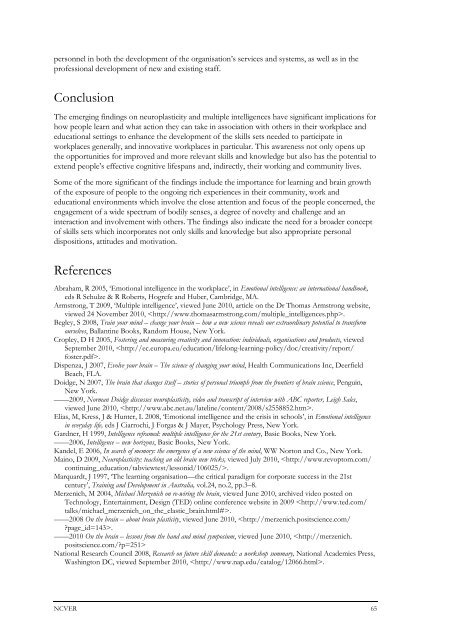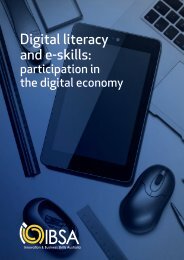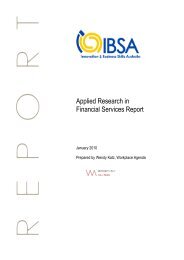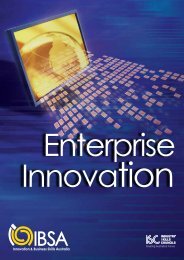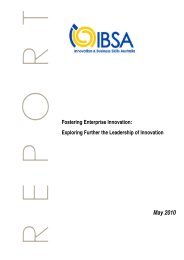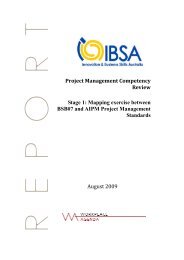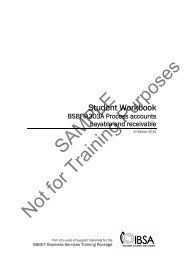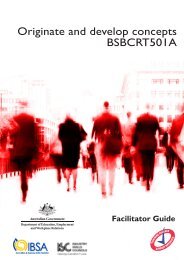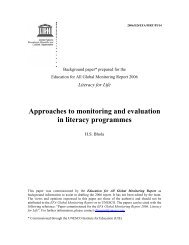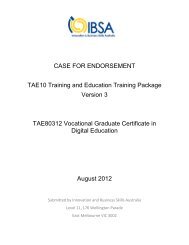quickly produce a diverse range of high-quality paper products to meet customer needs in small orlarge volumes with the flexibility of custom manufacturing and the efficiency of mass production.The company has an intensive training system for its staff with a focus on adaptation, problemsolving,quality assurance, teamwork, communication and learning from experience. In the courseof their careers, personnel gradually develop the skills sets required for working in the variousproduction areas of primary resource processing, pulping, reprocessing of waste paper, chemicalrecovery, wet-end operations, dry-end operations, coating, finishing and converting, waterprocessing and power and steam generation. Emphasis has been placed on using the full range ofsensory inputs to monitor and evaluate the status of production operations and to troubleshootidentified problems. For example, an operator would gauge the status of pulping operationsthrough sight (on control monitors and direct viewing of the product and the process), smell,sound (changes in pitch and intensity of the whine of the equipment), temperature and vibrations.The company actively promotes the concept of lifelong learning, with some guidance to staff onthe benefits of learning both on the job as well as in organised, structured formal training. A localTAFE college has an ongoing association with the company, working with company trainers andmentors. Senior personnel who have achieved a wide range and depth of experience play activeroles in both the troubleshooting of problems and the planning of the ongoing innovativedevelopment of the production facility. Highly experienced retired personnel are usually retained bythe company in both advisory and training capacities.Practical example 3: an innovative logistics freight-forwarding companyThis logistics freight-forwarding organisation is part of a vertically integrated global company thatprovides integrated logistics and freight-forwarding services both in Australia and across the world.Using innovative systems and ICT technology, strategic workplace structures and a mentoredprofessional development scheme, the organisation is able to provide highly efficient logisticsservices that transport, store and distribute a wide range of special freight 2 rapidly to any location inthe world. The organisation takes great pride in its ability to anticipate and manage anycontingencies that may arise in the course of a logistics project—from natural disasters, wars andpolitical conflicts, to industrial disputes and equipment failures. It also specialises in managing andfacilitating special major logistics projects such as industry exhibitions, major sporting events (suchas the Olympics Games or F1 Motor Racing), or the transport of materials and equipment neededfor the establishment of an industrial complex or mine in a remote location.The organisation is proud of its outstanding record for customer service and the quality and globalcompetitiveness of its logistics and freight-forwarding services. This is achieved through its focuson the innovative use of systems technologies across the whole supply chain and its commitment toensuring that its staff are highly skilled, adaptive, innovative and resourceful with an ongoingcommitment to learning both from experience and from formal training opportunities provided bythe company.In the course of their careers, personnel gradually develop the skills sets to work across a widerange of sections of the integrated logistics supply chain, including transport and distribution,storage and warehousing, domestic and international freight forwarding, the management of theimport, export and transiting of goods, customs-broking services and the tracing, tracking andtroubleshooting of cargo, from its point of origin, to its delivery destination. The organisation seesits strength as building a workforce of highly experienced adaptive personnel with an in-depthunderstanding of the whole supply chain and the systems technologies used to facilitate the logisticsand freight-forwarding services provided. The organisation has a culture of valuing the accumulatedskills, knowledge and experience of its staff and uses the expertise of its senior staff and retired2 Special freight includes goods that are refrigerated, fragile etc.64 Fostering enterprise: the innovation and skills nexus – research readings
personnel in both the development of the organisation’s services and systems, as well as in theprofessional development of new and existing staff.ConclusionThe emerging findings on neuroplasticity and multiple intelligences have significant implications forhow people learn and what action they can take in association with others in their workplace andeducational settings to enhance the development of the skills sets needed to participate inworkplaces generally, and innovative workplaces in particular. This awareness not only opens upthe opportunities for improved and more relevant skills and knowledge but also has the potential toextend people’s effective cognitive lifespans and, indirectly, their working and community lives.Some of the more significant of the findings include the importance for learning and brain growthof the exposure of people to the ongoing rich experiences in their community, work andeducational environments which involve the close attention and focus of the people concerned, theengagement of a wide spectrum of bodily senses, a degree of novelty and challenge and aninteraction and involvement with others. The findings also indicate the need for a broader conceptof skills sets which incorporates not only skills and knowledge but also appropriate personaldispositions, attitudes and motivation.ReferencesAbraham, R 2005, ‘Emotional intelligence in the workplace’, in Emotional intelligence: an international handbook,eds R Schulze & R Roberts, Hogrefe and Huber, Cambridge, MA.Armstrong, T 2009, ‘Multiple intelligence’, viewed June 2010, article on the Dr Thomas Armstrong website,viewed 24 November 2010, .Begley, S 2008, Train your mind – change your brain – how a new science reveals our extraordinary potential to transformourselves, Ballantine Books, Random House, New York.Cropley, D H 2005, Fostering and measuring creativity and innovation: individuals, organisations and products, viewedSeptember 2010, .Dispenza, J 2007, Evolve your brain – The science of changing your mind, Health Communications Inc, DeerfieldBeach, FLA.Doidge, N 2007, The brain that changes itself – stories of personal triumph from the frontiers of brain science, Penguin,New York.——2009, Norman Doidge discusses neuroplasticity, video and transcript of interview with ABC reporter, Leigh Sales,viewed June 2010, .Elias, M, Kress, J & Hunter, L 2008, ‘Emotional intelligence and the crisis in schools’, in Emotional intelligencein everyday life, eds J Ciarrochi, J Forgas & J Mayer, Psychology Press, New York.Gardner, H 1999, Intelligence reframed: multiple intelligence for the 21st century, Basic Books, New York.——2006, Intelligence – new horizons, Basic Books, New York.Kandel, E 2006, In search of memory: the emergence of a new science of the mind, WW Norton and Co., New York.Maino, D 2009, Neuroplasticity: teaching an old brain new tricks, viewed July 2010, .Marquardt, J 1997, ‘The learning organisation—the critical paradigm for corporate success in the 21stcentury’, Training and Development in Australia, vol.24, no.2, pp.3–8.Merzenich, M 2004, Michael Merzenich on re-wiring the brain, viewed June 2010, archived video posted onTechnology, Entertainment, Design (TED) online conference website in 2009 .——2008 On the brain – about brain plasticity, viewed June 2010, .——2010 On the brain – lessons from the hand and mind symposium, viewed June 2010, National Research Council 2008, Research on future skill demands: a workshop summary, National Academies Press,Washington DC, viewed September 2010, .NCVER 65
- Page 1:
Fostering enterprise:the innovation
- Page 4 and 5:
© Commonwealth of Australia, 2011T
- Page 7 and 8:
ContentsContributors 6Overview - Pe
- Page 9 and 10:
Ludger Deitmer works as a senior re
- Page 11 and 12:
Australian Chamber of Industry and
- Page 13 and 14:
low-profile changes in processes or
- Page 15 and 16: that there are no generic innovatio
- Page 17 and 18: Thinking about the VET system speci
- Page 19 and 20: (of a vocation), as this increases
- Page 21: In an economic sense, the creation
- Page 24 and 25: the Korean War, to the success of i
- Page 26 and 27: products and processes, and then ex
- Page 28: Archibugi, D & Michie, J 1995, ‘T
- Page 31 and 32: What is this thing called innovatio
- Page 33 and 34: or soft skills. We can look at an e
- Page 35 and 36: Table 4 Skills used by innovation-a
- Page 37 and 38: In a study on the R&D technicians
- Page 39 and 40: aims to ‘ensure increased utilisa
- Page 41 and 42: influenced by the engineers but als
- Page 43 and 44: lack of research into the interrela
- Page 45 and 46: and control technologies to a great
- Page 47 and 48: fees to be paid to industrial bodie
- Page 49 and 50: Figure 2The apprenticeship training
- Page 51 and 52: Keeping a training log book is lear
- Page 53 and 54: Rauner, F, Rasmussen, L & Corbett,
- Page 55 and 56: workplaces are likely to have the s
- Page 57 and 58: and processing system, which was es
- Page 59 and 60: neuroplasticity and multiple intell
- Page 61 and 62: surroundings as much as possible, c
- Page 63 and 64: Personal and professional developme
- Page 65: In particular, in the course of the
- Page 69 and 70: Why firms innovate andwhat it means
- Page 71 and 72: Adopting new or improved technologi
- Page 73 and 74: financial services (including life
- Page 75 and 76: ates. Cross-skilling and rostering
- Page 77 and 78: Resources for innovationImplementat
- Page 79 and 80: occupational skills can also be lea
- Page 81 and 82: The role of education and skillsin
- Page 83 and 84: Managerial innovation—Australia
- Page 85 and 86: al. 2009). A vast literature exists
- Page 87 and 88: In 2009, the London School of Econo
- Page 89 and 90: talent and address poor performers.
- Page 91 and 92: Figure 4Level of education—a glob
- Page 93 and 94: Skill and education—a cross-exami
- Page 95 and 96: Sub-group based on management pract
- Page 97 and 98: In summary, the analysis above rein
- Page 99 and 100: Table 9Econometric analysis of firm
- Page 101 and 102: Commonwealth of Australia 2008, Rev
- Page 103 and 104: Appendix A: The 18 dimensions of ma
- Page 105 and 106: Building innovation capacity:the ro
- Page 107 and 108: to innovate in order to then be cap
- Page 109 and 110: formation tool that can be implemen
- Page 111 and 112: The role of HRM in innovationThere
- Page 113 and 114: population was limited to private s
- Page 115 and 116: performance. By comparison, the inn
- Page 117 and 118:
Schroeder, RG, Scudder, GD & Elm, D
- Page 119 and 120:
The predominance of a tacit element
- Page 121 and 122:
Table 1 Innovation frequencies by A
- Page 123 and 124:
flagged by highly significant (p <
- Page 125 and 126:
Generally, evidence suggests a degr
- Page 127 and 128:
AppendixScope of the BLDThe scope o
- Page 129 and 130:
Tradespeople and techniciansin inno
- Page 131 and 132:
products or services introduced ove
- Page 133 and 134:
who report overwhelmingly that thei
- Page 135 and 136:
more complex problem-solving: ‘as
- Page 137 and 138:
occupations such as scientists, eng
- Page 139 and 140:
TeachingWithin universities some tr
- Page 141 and 142:
of trades and technicians who had a
- Page 143 and 144:
implemented organisation-wide syste
- Page 145 and 146:
OECD (Organisation for Economic Co-
- Page 147 and 148:
first such studies on this topic an
- Page 149 and 150:
Training managers reported that the
- Page 151 and 152:
factors. Culturally, mining compani
- Page 153 and 154:
In terms of formal training, the tw
- Page 155 and 156:
The medium-console game companies t
- Page 157 and 158:
Mining firms use a Tayloristic work
- Page 159 and 160:
additional stream of funding explic
- Page 161 and 162:
detracted from economic growth for
- Page 163:
National Centre for Vocational Educ


